If there’s a sound that can stir the soul and leave it plucked and humming, it’s the unique resonance of a 12-string guitar. But discarding the lyrical poetry, let me tell you when this all started. I had been playing the conventional 6-string guitar for quite some time when a chance meeting with a 12-string in a dim-lit music store changed everything. The first strum was magical, its rich, chiming tone completely enthralling. In a flash, my world of music exploded, akin to unearthing a hidden chamber in a well-explored castle. But let’s pause here, the full story unfolds as we dig into the virtues of the best 12-string acoustic guitars in this guide.
Over the years, my journey as a fingerstyle guitarist swirled around a series of 12-string guitars, each with its distinct voice and personality. The harmonious richness, the enhanced chordal textures – there was so much more to play with. It wasn’t an easy transition; handling the increased tension, adapting to the wider neck. But these same challenges became my own co-conspirators, refining my technique, extending my musical expression, fostering an intimate and insightful relationship with the 12-string’s true potential.
My goal is to share my cumulative knowledge and experience in this comprehensive guide to the best 12-string acoustic guitars. As we explore the various models and brands, let’s dive into a world of beauty, complexity and an uncanny knack for stirring your musical sensibilities.
Top-Rated 12-String Acoustic Guitars
| Model | Brand | Body Style | Top Material | Back & Sides Material | Neck Material | Fingerboard Material | Electronics | Price Range |
|---|---|---|---|---|---|---|---|---|
| Taylor 150e | Taylor | Dreadnought | Solid Sitka Spruce | Layered Walnut | Maple | West African Crelicam Ebony | Expression System 2 | Mid |
| Martin D12X1AE | Martin | Dreadnought | Sitka Spruce | Mahogany Pattern HPL | Select Hardwood | Richlite | Fishman Sonitone | Mid |
| Guild F-512 | Guild | Jumbo | Solid Sitka Spruce | Solid Rosewood | 3-Piece Mahogany/Walnut/Mahogany | Indian Rosewood | None (Acoustic) | High |
| Yamaha FG820-12 | Yamaha | Traditional Western | Solid Spruce | Mahogany | Nato | Rosewood | None (Acoustic) | Low |
| Fender CD-140SCE-12 | Fender | Dreadnought Cutaway | Solid Spruce | Laminated Mahogany | Maple | Rosewood | Fishman Presys | Low to Mid |
Taylor 150e
best for balanced tone and playability
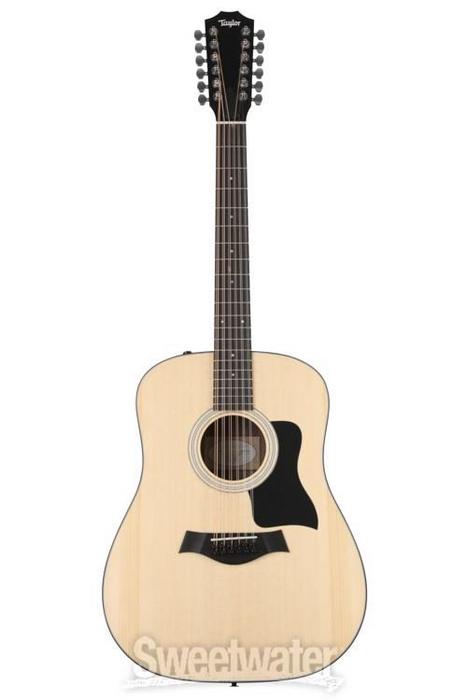
In the vast arena of top-rated 12-string acoustic guitars, the Taylor 150e is an instrument ripe with relevance and plays a vital role specifically for its unmatched balance in tone and playability. There’s an easy familiarity while playing the Taylor 150e, that gives birth to an unparalleled connection between musician and instrument.
These Taylor 12-string guitars are a synonym for harmonious balance – their solid tops demonstrate their versatility, producing rich lows complemented by crisp highs. Being an electric-acoustic 12-string guitar, it is ingeniously adaptable, meeting the demands of any performance setting, be it an intimate solo gig or a jam-packed concert hall. Hitting the perfect chord with the 150e reminds me of a past intimate performance where its chilling clarity left the audience spellbound.
The admirably balanced tonewoods which add up to the 150e’s extraordinary tone, enhance its playability degree, making it a joy to play at all times. The smooth neck profile and finger-friendly fretboard design make for a comfortable play, accommodating complex fingerstyle patterns effortlessly.
Pros:
- Optimal balance in tone, suited for various genres and playing styles.
- Perfect blend of a dreadnought’s projection and added clarity of a 12-string.
- Electric-acoustic versatility enhances playability in diverse settings.
Cons:
- Lack of intricate aesthetic detailing compared to pricier models.
- May need frequent setup adjustments for fresh strings or playing conditions.
When comparing to the Guild F-512, the 150e undeniably offers a more modern and versatile sound, though it may lag in some of the Guild’s traditional acoustic flair. And, unlike the Yamaha FG820-12, the 150e infuses an undeniable aura of craftsmanship, making it stand out smarter.
In summary, the Taylor 150e maintains an enviable position in the family of 12-string guitars, owing to its balanced approach to tone and playability. It is in these aspects that the Taylor 150e has influenced not just me, but a generation of avid 12-string players worldwide.
Martin D12X1AE
best for affordability and brand reputation
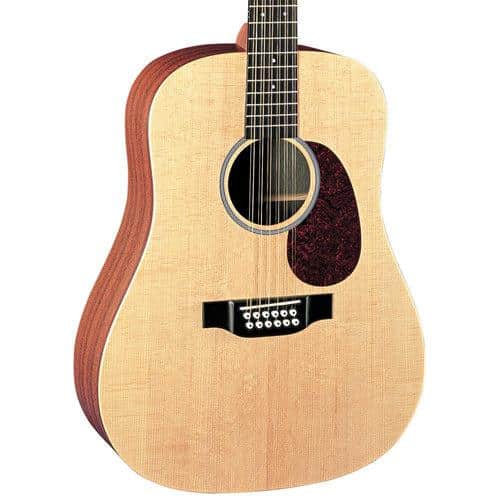
In my years as a guitarist, I’ve had the opportunity to play various models, but very few match the Martin D12X1AE when it comes to affordable 12-string guitars. The balance of affordability and sound quality it offers is truly commendable.
Among its peers in our list of top-rated 12-string acoustic guitars, the D12X1AE stands out for me because of the signature Martin tone it resonates. This Martin 12-string guitar has a richness to its sound that beautifully encapsulates both my folk and classical influences. I remember performing at a local pub, the engaging timbre of the D12X1AE startlingly conspicuous in a room full of other branded guitars. That night, the D12X1AE not only showcased its sound clarity but also its durability.
Compared to the Taylor 150e, the D12X1AE falls behind in terms of brightness but excels in delivering a robust, fuller sound. It might not be as ornate as the Guild F-512, but the Martin model compensates for its simpler aesthetics with an equally impressive sound projection. It holds its own next to the Yamaha FG820-12 and Fender CD-140SCE-12, providing excellent value for its price point.
Pros:
- Uncompromised Martin tone integrality.
- Great value for money.
- Exceptional sound robustness and durability.
Cons:
- Less bright compared to some models like the Taylor 150e.
- Simpler aesthetics compared to Guild F-512.
In conclusion, the Martin D12X1AE is a dream come true for any musician seeking a quality 12-string guitar without breaking the bank. Its sound, durability, and overall performance are representative of the Martin legacy, contributing significantly to its repute among top-rated 12-string guitars. If you seek to explore the dynamic textures of a 12-string, you couldn’t go wrong with the D12X1AE.
Guild F-512
best for classic design and premium construction
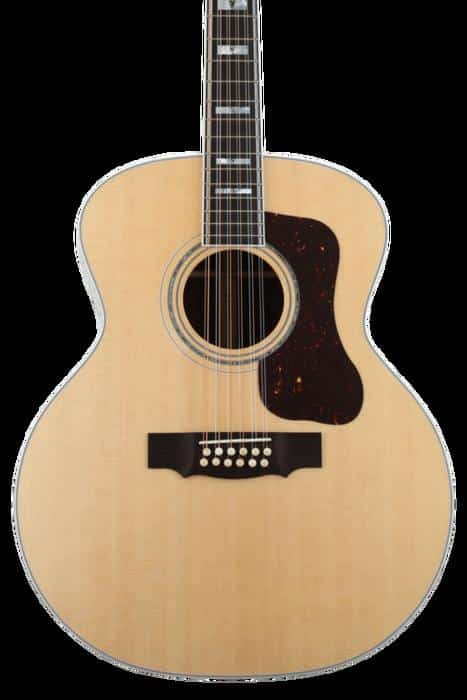
As a seasoned guitarist, the moment I held the Guild F-512, I was plunged into a sensory delight. Hallmarked by remarkable craftsmanship, this premium 12-string acoustic guitar embodies traditional guitar-making at its best. In comparison to others in the ‘Top-Rated 12-String Acoustic Guitars’ category such as the Yamaha FG820-12 or the Taylor 150e, the Guild F-512 stands out for its venerable lineage and proven endurance.
My picking hand immediately connected with the superior touch of the solid Sitka spruce top, while the sumptuous Indian Rosewood back and sides resonated with a warmth and depth that only the best tonewoods can deliver. Every note and chord rung out with clear, symphonic resonance—a tribute to the excellent 12-string guitar craftsmanship Guild is famed for.
On the stage, this gem shines. The sound projection is phenomenal. Once, during a performance, a string on my reliable Fender CD-140SCE-12 snapped. I quickly switched to the Guild F-512 mid-song. The transition was impeccable. The Guild F-512 added an extra layer of sonic richness that the audience loved. And, as a personal testament, my connection with the F-512’s classic design made the performance significantly more emotionally satisfying.
Pros:
- Exceptional tonal quality, thanks to premium tonewoods.
- Superior sound projection and resonance.
- Iconic, classic design that feels soothingly familiar.
Cons:
- Price may be steep for beginners.
- Not as lightweight as other models like the Martin D12X1AE.
The Guild F-512’s offering occupies sacred ground for aficionados of 12-string guitars. While certain models in the parent category might offer contemporary features or a lighter design, none quite match the F-512 in encapsulating acoustic prowess and a timeless design. Its pure, unmistakable tone is proof that true artistry never fades—it merely resonates with a stronger echo through time.
Yamaha FG820-12
best for beginners and reliability
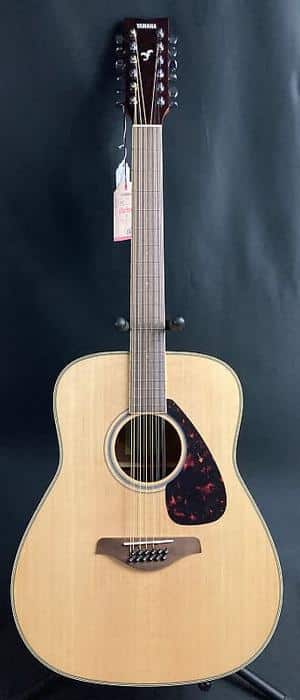
In the world of top-rated 12-string acoustic guitars, the Yamaha FG820-12 stands as a beacon of reliability, especially for beginner guitarists. Yamaha 12-string guitars have a reputation for their consistent high-quality build and sound, and the FG820-12 follows suit. As an educator and long-time guitarist, a specific instance that highlighted its value occurred when I gifted this model to a student. Her improvement and growing enjoyment were tangible, confirming my belief in the viability of beginner 12-string guitars like the Yamaha FG820-12.
The guitar’s solid spruce top and mahogany back and sides provide a unique blend of brightness and warmth, making the exploration of a wide range of musical genres possible. Its playability, a crucial factor for beginners, is commendable; beginners need not stretch their fingers much despite the additional strings. Its smooth-touch neck and durability make it a fantastic long-term investment.
Directly comparing it with the Taylor 150e and the Martin D12X1AE brings out the uniqueness of each. The airy brightness of Taylor 150e feels different from the rich warmth of the Yamaha FG820, while the Martin D12X1AE stirs up a slightly different tonal quality. Though each offers a distinct musical experience, the Yamaha FG820-12’s affordability further underscores its suitability for beginner guitarists.
Pros:
- High-quality construction ensures durability.
- Easy playability with a comfortable neck width.
- Affordable within the quality 12-string guitar range.
Cons:
- The sound may not resonate as much as high-end models.
- Beginners may initially find managing 12-strings challenging.
In conclusion, the Yamaha FG820-12 perfectly fulfills my search for a beginner-friendly and reliable 12-string guitar. Its solid attributes put it on par with other models discussed in this article, effectively reinforcing Yamaha’s reputation for quality acoustic guitars.
Fender CD-140SCE-12
best for modern features and versatility

‘Best for modern features and versatility’ – the Fender CD-140SCE-12 stands tall in the distinctive category of top-rated 12-string acoustic guitars. As a performing artist, I’ve had the opportunity to test numerous electric-acoustic 12-string guitars in various settings. And the CD-140SCE-12 has shown exceptional 12-string guitar value for money.
One memorable night, I found myself in a bustling main-stage setup, with the CD-140SCE-12 as my trusted sidekick. Amidst the clamour, I knew I could rely on this guitar’s consistent sound output, thanks to its on-board electronics. On quieter gigs, like at a small coffee shop, it complemented the intimate ambience perfectly. One guitar had indeed adapted to my diverse career.
However, no review is complete without its touch of stark veracity. Comparing the Guild F-512 and the Fender CD-140SCE-12 throws light on contrasting 12-string guitar features. The Guild does bring a unique charm with its quintessential jumbo design and solid Sitka spruce top, but the Fender’s cutaway design grants notable access to upper frets, a feature that has frequently been my saving grace. It’s all about what suits your musical style.
But the Martin D12X1AE, yet another formidable competitor, with its sustainable wood certified parts, fails to deliver the electronics that the CD-140SCE-12 so effortlessly provides.
Pros:
- Offers value for money with commendable features like the on-board electronics and cutaway design.
- Ensures sound consistency across different settings.
Cons:
- Lacks the vintage, iconic design of some competitors.
- The default strings could use an upgrade for optimum performance.
In conclusion, the Fender CD-140SCE-12 promises versatility and modern features at a reasonable price. My experience can vouch for this guitar’s excellent contribution amongst top-rated 12-string acoustic guitars.
What to Consider When Buying a 12-String Guitar
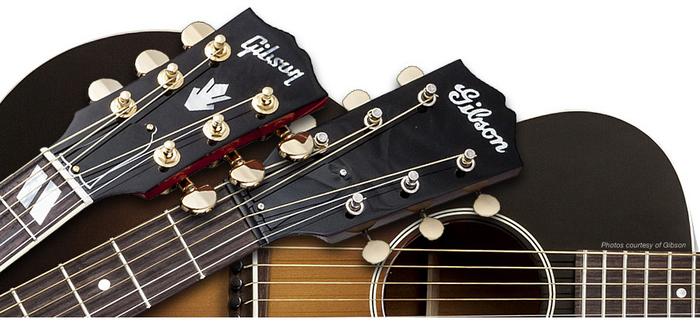
Finding the perfect 12-string guitar could be a life-changing experience. It’s akin to a meeting of minds and souls, with the guitar being a tangible extension of your musical persona. The joyous symphony of oscillating strings, harmonizing on command of your fingertips, is a thrill that every guitarist cherishes. Sound, playability, and value are key concerns when venturing into the folksy, lush landscape of 12-stringed instruments. But it’s also about something much more subjective – that connection, or rapport, you build with your guitar over years of play.
Over years of playing and exploring a myriad of genres, I’ve handled many a 12-string guitar. Each one is unique, from the warmth of its sound to the feel of its body against my palm. I’ve learned to look beyond the cold specs on a label and instead tune in to the personality of the instrument. I’ve found that the deeper aspects like choice of tonewood, construction methods, and feature set impact a guitar’s playability and tonal characteristics. My musical journey, meandering through a host of styles, has attuned my ears to these subtle differences and honed my sense for what truly elevates an instrument.
When embarking on your 12-string guitar comparison, consider your personal taste. If you prefer a rich, warm tone, opt for a guitar with a spruce or cedar top. Maybe you’re more partial to a crisp, bright sound, in which case, a maple top would be your best bet. The tonewood used in a guitar directly affects its sound – and you’ll find that you might have to kiss a few frogs to find your prince!
Lend your attention to the construction method too. An all-solid-wood 12-string guitar, although costlier, resonates more freely and offers a richer, fuller sound. On the other hand, a laminate guitar, while being more affordable, can be a great choice for beginners or as a reliable gigging guitar, resilient to humidity and temperature fluctuations.
Paying heed to the 12-string guitar pricing is essential. You won’t need to break the bank to acquire a good 12-string guitar. Brands like Fender and Yamaha offer great value with their reasonably priced models. But if a higher end model catches your fancy, Gibson and Martin bring unmatched craftsmanship and tonal excellence to the table. Weigh your options and make a choice that aligns with your budget and musical aspirations.
What if the perfect 12-string acoustic guitar was waiting for you, and you just needed to know what to look for? Unlock the key considerations that can lead you to your musical soulmate. A guitar’s features, like the nut width and neck radius, shape its playability. If you’re transitioning from a 6-string, finding a 12-string guitar with a narrow nut width could make the switch simpler. Electric players might prefer a smaller neck radius for a more snug fit.
Remember, every 12-string guitar has its distinct character and charm, a reflection of the combination of its tonewood, construction, and features. Your quest is to find the one that resonates with your musical voice, encapsulates your style and facilitates your journey into the enchanting world of 12-string soundscapes. Whether you’re chasing the chiming sound of a “Hotel California” intro or the deep resonance of a folk tune, your 12-string companion awaits.
As we journey forward in this article, we’ll dive deeper into the world of 12-string guitars. We’ll explore playing techniques, maintenance tips, and provide answers to frequently asked questions. So hold on, my friends, as we strum our way through this musical adventure.
Playing and Maintaining Your 12-String Guitar
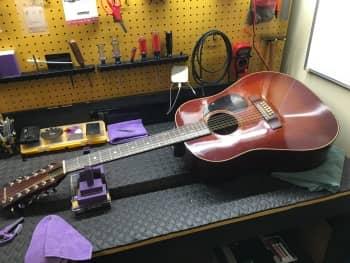
Delving into the world of 12-string guitars is an exciting journey echoed with the resonance of doubled strings and deepened tonality. There’s a distinctive thrill that courses through me as I press down on the frets and pluck at the dozen strings, coaxing out a sound that permeates the space with its rich depth. However, the pleasure of 12-string guitar playability goes hand in hand with the responsibility of maintenance, a delicate dance that informs the essence and output of these professional 12-string guitars.
The enchanting allure of a well-tuned 12-string never ceases to mesmerize. The doublings create a chorus-like effect, a haunting echo that transforms each note into a harmonic wave. A rush of anticipation shivers through me each time my fingers dance on the frets of my Taylor 150e, or when I coax sweet, resounding music from my Guild F-512. These coveted brands have proudly served me well during the countless hours dedicated to shaping my craft and expressing my soul.
Maintaining a 12-string guitar is an art in itself; could it be the secret to that mesmerizing sound? Let’s delve into the rituals that keep these intricate instruments in harmonious condition. Each twist of a machine head on my Fender CD-140SCE-12 is like an intimate conversation. Swiftly I find the perfect pitch, shaping the melodic current running through the strings. Regularly working with a tuner, I’ve learned to discern the subtle variations in tonal quality, an ear tuned by countless rounds of precision tuning on stages, in studios and teaching sessions.
The role of maintenance extends beyond the realms of tuning. It’s about preserving, and sometimes even enhancing, the unique character of your instrument—a lesson I’ve learned over long periods of active participation in 12-string acoustic guitar forums. Participants’ shared wisdom emphasized the importance of attending to the fretboard, the saddle, the neck, and the bridge with care, for, like any acoustic instrument, longevity and optimal performance are direct results of keeping a keen eye on its condition.
From countless hours of practice to lively discussions with fellow musicians, I realized that a well-cared guitar develops a voice of its own—it sings not only the melodies you play but also the one cultivated within its core over years of interactions: the fingerprints on its body, the worn spots on the strings, and the way it adjusts to the nuances of your personal style. Just as the sheen on my Yamaha FG820-12’s fretboard reflects the countless times strings have been pressed onto it, the richness of the sound reveals the depth of bond formed between us.
Beyond the aesthetic allure and engaging nature of the 12-string guitar lies its foundational necessity—the balance of tension. Maintaining this equilibrium ensures the longevity and consistent expression of your instrument, a point I repeatedly find myself making as a tutor. The interplay of the twelve strings demands keen attention. Carefully managing the tension of each string in relation to its octave counterpart has become a part of my daily ritual—a personal touch that has been shaped and honed over time.
My story is a testament to the artistry of not only playing but also maintaining a 12-string guitar—a commitment to preserving their harmonic integrity. An observant eye, a discerning ear, and an inherent reverence for the instrument itself, can draw out the enchanting melodies held within the heart of any 12-string guitar.
FAQs
What is a 12-string acoustic guitar?
Why should I consider a 12-string acoustic guitar?
What should I look for when buying a 12-string acoustic guitar?
What are some top-quality brands for 12-string acoustic guitars?
Conclusion
The journey to find the best 12-string acoustic guitar comes to a close, but could the next chapter in your musical story be just beginning? Let’s reflect on the symphony of strings that could shape your future melodies. Consider the value for money these 12-string guitar recommendations provide. From the vibrant tones of the Taylor 150e to the well-balanced resonance of the Martin D12X1AE, the punchy gusto of Guild F-512, the versatility of Yamaha FG820-12, or the welcoming affordability of Fender CD-140SCE-12.
Providing insights, I share not just a list of recommendations, but a piece of my life’s soundtrack as influenced by the 12-string guitar. The personal connections I’ve made with each strum reflect years of practice, performances, and passion. It is my hope that this guide resonates as an authentic voice of experience, helping others in their quest for an instrument that sings with the same fervor as their musical dreams.
Selecting the ideal 12-string guitar is a journey that spans beyond the initial purchase. It’s about the art of playing and maintaining your 12-string with dedication and love. It’s about understanding its nuances, subtleties, and the irresistible charm that makes it such a prized possession in a musician’s collection.
So, now it’s your turn. Will you choose value for money or lean towards the recommended model that accommodates your playing style best? Whichever way your heart leads, remember that the 12-string guitar is more than just a musical instrument. It’s a companion that will accompany you on your musical journey, ready to echo your feelings, create your sound, and shape your unique musical story.